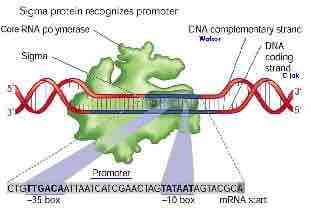Sigma factors are groups of proteins that regulate transcription and therefore function in house-keeping, metabolic, and regulation of growth processes in bacteria. Sigma factor expression is often associated with environmental changes that cause changes in gene expression . The regulation of expression of sigma factors occurs at transcriptional, translational, and post-translational levels as dictated by the cellular environment and the presence or absence of numerous cofactors.

Sigma Factor Regulation of Transcription
An overview of how sigma factors regulate the transcriptional process.
Sigma factors include numerous types of factors. The most commonly studied sigma factors are often referred to as a RpoS proteins as the rpoS genes encode for sigma proteins of various sizes. In E. coli, the RpoS is the regulator of growth phase genes, specifically in the stationary phase. The RpoS is critical in the general stress responses and can either function in promoting survival during environmental stresses, but can also prepare the cell for stresses. Specifically, the translational control of the sigma factor is a major level of control.
The translational control of sigma factors involves the presence and function of small noncoding RNAs. Using RpoS proteins as the focus, the RpoS expression and transcription is regulated at the translational level. Small noncoding RNAs are able to sense environmental changes and stresses resulting in increased expression of RpoS protein. The small noncoding RNAs are able to specifically increase the amount of rpoS mRNA that undergoes translation.
The resultant increase of RpoS protein is based on the cellular environment and its needs. There are numerous classes of small noncoding RNAs that function in RpoS regulation, including DsrA, RprA and OxyS. These small noncoding RNAs are capable of sensing changes in temperature (DsrA), cell surface stress (RprA) and oxidative stress (OxyS). These RNAs can induce activation of rpoS translation. However, there are small noncoding RNAs, such as LeuO, that are capable of inhibiting rpoS translation as well via repression mechanisms. The regulation of rpoS translation is complex and involves cross-signaling and networking of numerous proteins and the regulatory small noncoding RNAs.